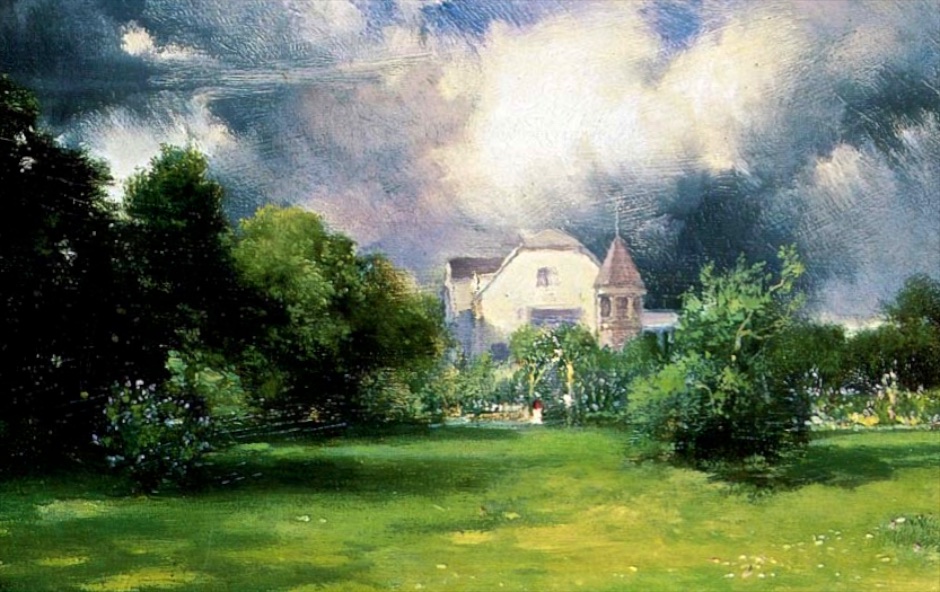 Thomas Moran, The Artist’s House, 1895, Courtesy of Sothebys
Thomas Moran, The Artist’s House, 1895, Courtesy of Sothebys
—————————————————-
THE STUDIO
THE HOME AND WORKSHOP OF THOMAS MORAN AND MARY NIMMO MORAN
229 MAIN STEET, EAST HAMPTON
HISTORIC STRUCTURE REPORT
Prepared by: Robert Hefner
With research by: Rosanne Barons
April 2009
Prepared for:
The Inc. Village of East Hampton
Select Drawings, Illustrations, Photographs, with Copy Excerpts. To see the original Historic Structure Report, contact the Village of East Hampton.
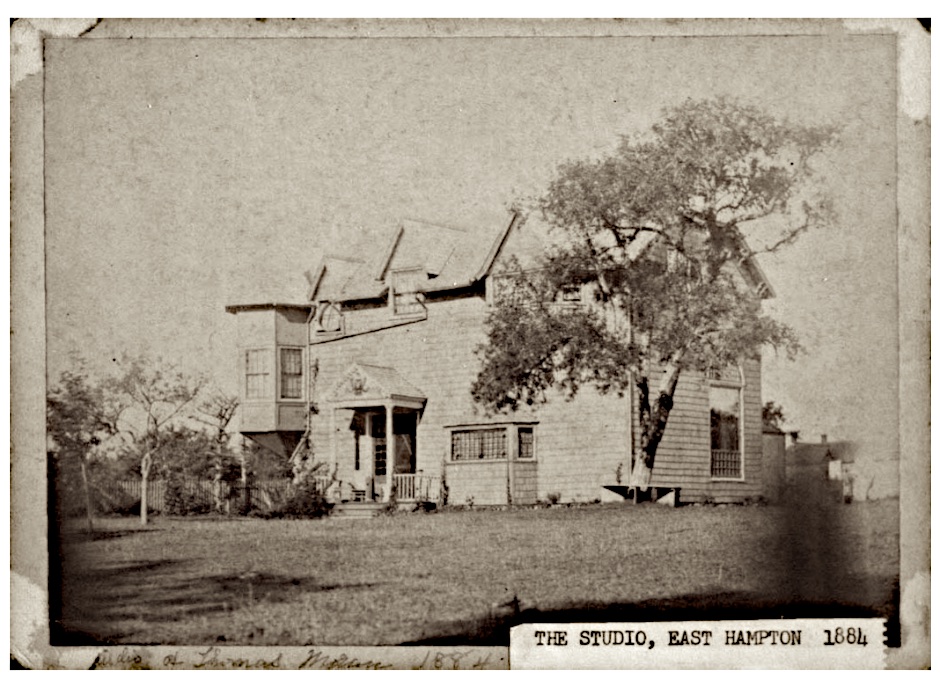 The Studio, c. 1886. This is the earliest known photograph of The Studio.
The Studio, c. 1886. This is the earliest known photograph of The Studio.
Ruth Moran’s handwritten notes about her father include this: “the old Studio which he built from his own designs in 1884…”
The determining feature of Thomas Moran’s design is the one large 24’ x 40’ two-story space which was entered directly through the front door and which was intended to be an art studio first and living space second. Bedrooms were on the third floor. The service wing for food preparation and domestic chores was a minimal attachment, if it existed at all in 1884.
Thomas Moran’s idea of a single studio space for multiple activities with a suite of bedrooms for the family perched on top determined much of the character of The Studio: its essential simplicity, its modest scale, and its informality. It was a simple concept that allowed Thomas Moran to be the designer and to easily collaborate with Stafford Tillinghast (the builder) in determining the mechanics of construction.
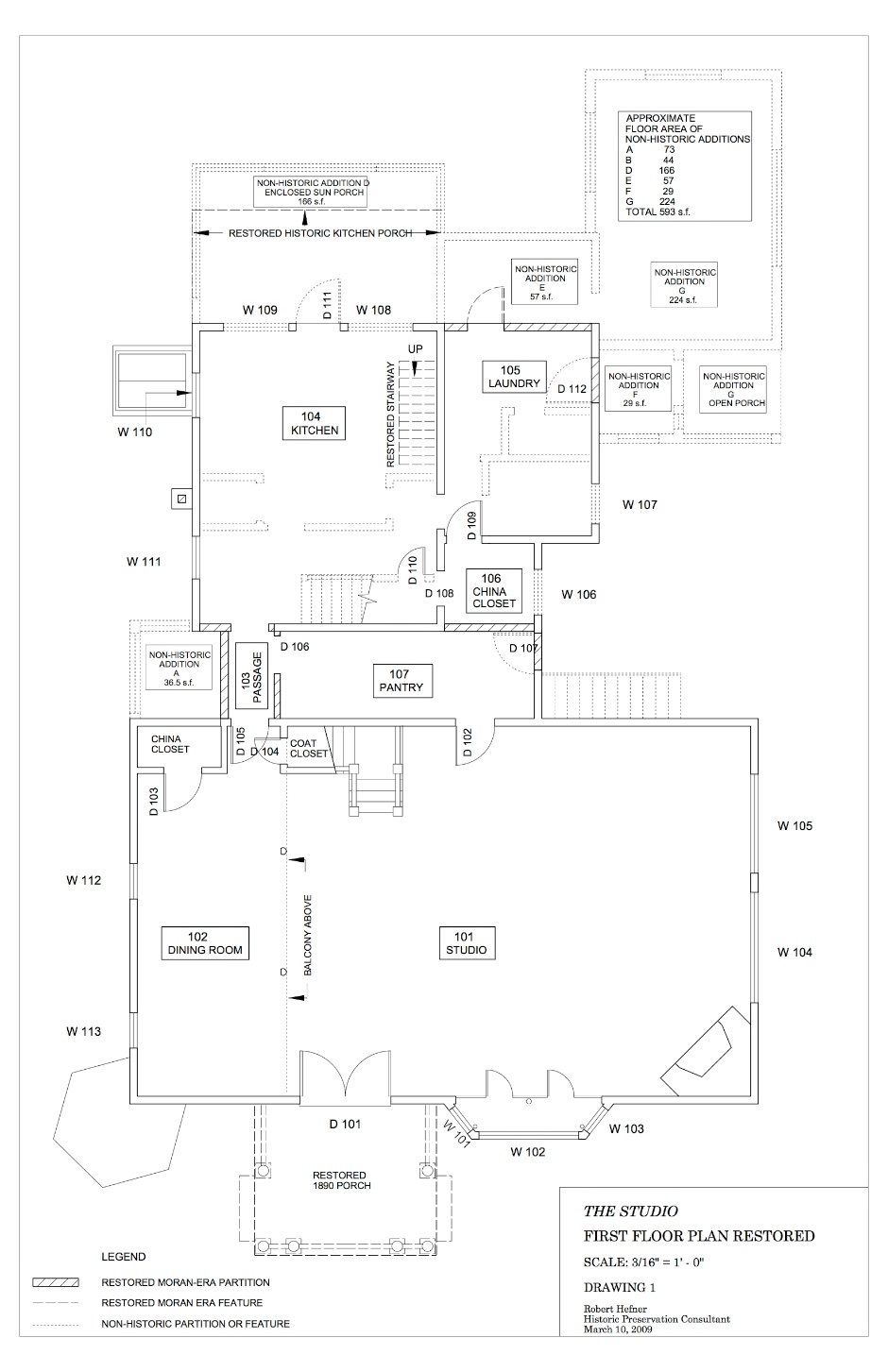
Thomas Moran was clearly influenced by the English Queen Anne style in giving The Studio an appropriately artistic exterior. Queen Anne features include: the overall asymmetrical composition of the front façade; the many different types of windows; the Queen Anne window sash with large panes of glass surrounded by a border of small panes; the projecting oriel window and bay window on the front façade; the corner turret with its steep cap; the dormers with steep gables; the clipped gables; and the paneled chimney stack. While most Queen Anne houses have a complex plan, Stafford Tillinghast built a simple barn-like structure that Thomas Moran decorated with asymmetrically-placed features typical of the Queen Anne style.

While the Queen Anne style was the overall guide, it was Thomas Moran’s use of salvaged components that give The Studio its unique and personal character. Like many of his fellow artists of the period, Moran was a famous collector. The inventories of the contents of The Studio attest to the variety of objects he assembled there. Ruth Moran wrote of her father: “He took great joy in all beautiful artistic things; rugs, and bronzes – and he spent his money lavishly to get them. Certain things that he and my mother bought in their youth he took with him whenever he traveled away from home, because something in their form or beauty was necessary to him, and so appealed that he felt their need wherever he might be.” Moran had much experience in shipping objects in connection with his travels to the west and to Europe. His fearlessness in collecting large objects and having them transported long distances is exemplified by his purchase of a gondola in Venice in 1890:
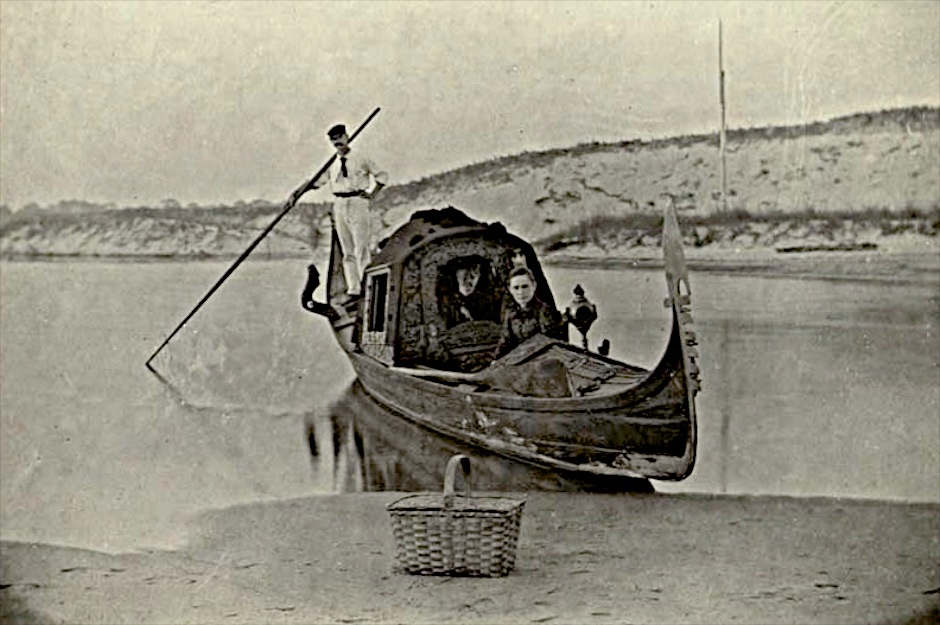 This photograph shows George Fowler, Ruth Moran and Mary Moran Tassin on board Thomas Moran’s gondola on Hook Pond.
This photograph shows George Fowler, Ruth Moran and Mary Moran Tassin on board Thomas Moran’s gondola on Hook Pond.
“Thomas Moran, the artist, who has a summer residence and studio at East Hampton, while in Venice purchased the gondola and its outfit that belonged to the poet Browning. It was brought to this place by the steamer Shelter Island last Sunday morning, hung to the davits, it being so long – some thirty six feet – that it could not be taken in on deck. Tuesday Mr. Moran was in town overseeing its shipment by teams to East Hampton, where he is to have it placed in Hook Pond.” — East Hampton Star, September 6, 1890.
“That is Robert Browning’s gondola that we bought in Venice,” the voice of the artist says. “It is the gondola which the poet used all the time he was in the city of the Adriatic. In it he wrote ‘In the Gondola.’ — New York Post, 1897.
During the first half of 1884 Moran kept an eye out for buildings in New York that were scheduled to be demolished and salvaged components from them. Ruth Moran recalled that “Mr Moran bought much old Mahogany stair rails newell posts etc” and noted that in the studio was “an old Colonial mantel.” Thomas Moran may have salvaged the front doors and the studio window from an 1874 building at 938 Broadway, five blocks from his home, that was demolished in 1884….Salvaged components incorporated in the initial construction of The Studio in 1884…[include] the front doors from a New York commercial building; the studio window which is a New York storefront display window; three large (36” x 78”) sixty-light sash that were probably storefront transoms; two Ionic pilasters from a New York entrance; six newel posts, handrails and balusters from New York Greek Revival period residences; and two federal period mantels…Salvaged items that Moran added to The Studio after 1884 include the two leaded glass fanlights over the studio windows and a piece of Eastlake paneling used as a door to the turret.
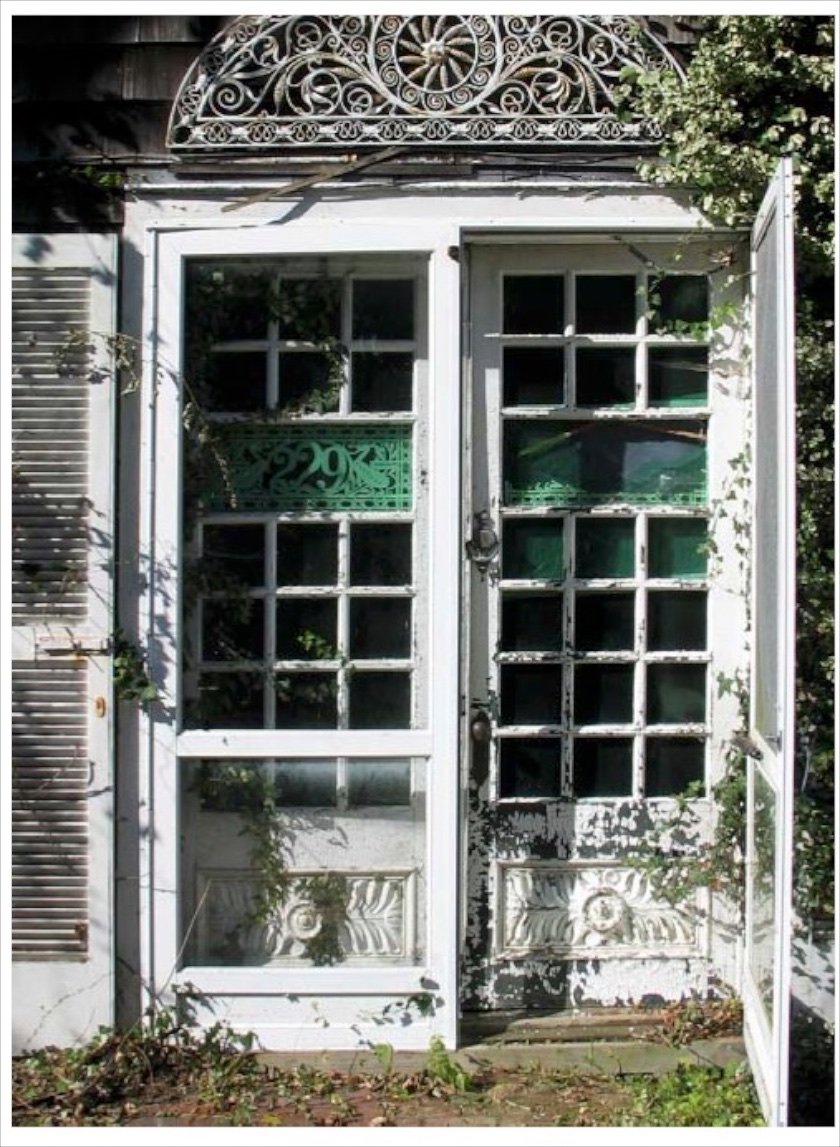 The front doors were salvaged from a New York City commercial building.
The front doors were salvaged from a New York City commercial building.
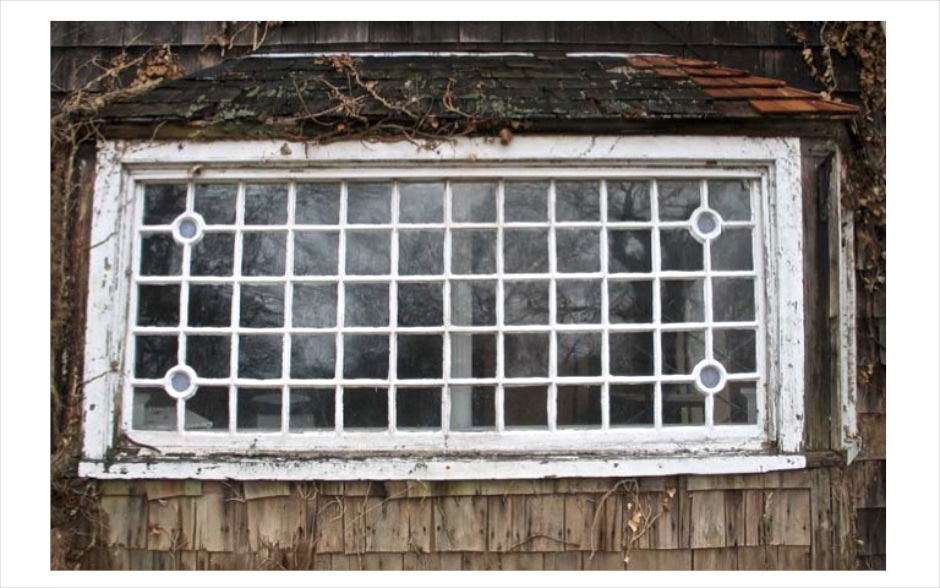 This large (36″ x 78″) fixed sash in the studio bay window was probably a storefront transom…
This large (36″ x 78″) fixed sash in the studio bay window was probably a storefront transom…
 The 1884 studio window (to the right) is a storefront display window apparently salvaged from the same building as the front doors. In the studio it is upside down with the transcom at the bottom. Thomas Moran may have installed the salvaged leaded-glass fanlights later when a second studio window (to the left) was added to the north wall.
The 1884 studio window (to the right) is a storefront display window apparently salvaged from the same building as the front doors. In the studio it is upside down with the transcom at the bottom. Thomas Moran may have installed the salvaged leaded-glass fanlights later when a second studio window (to the left) was added to the north wall.
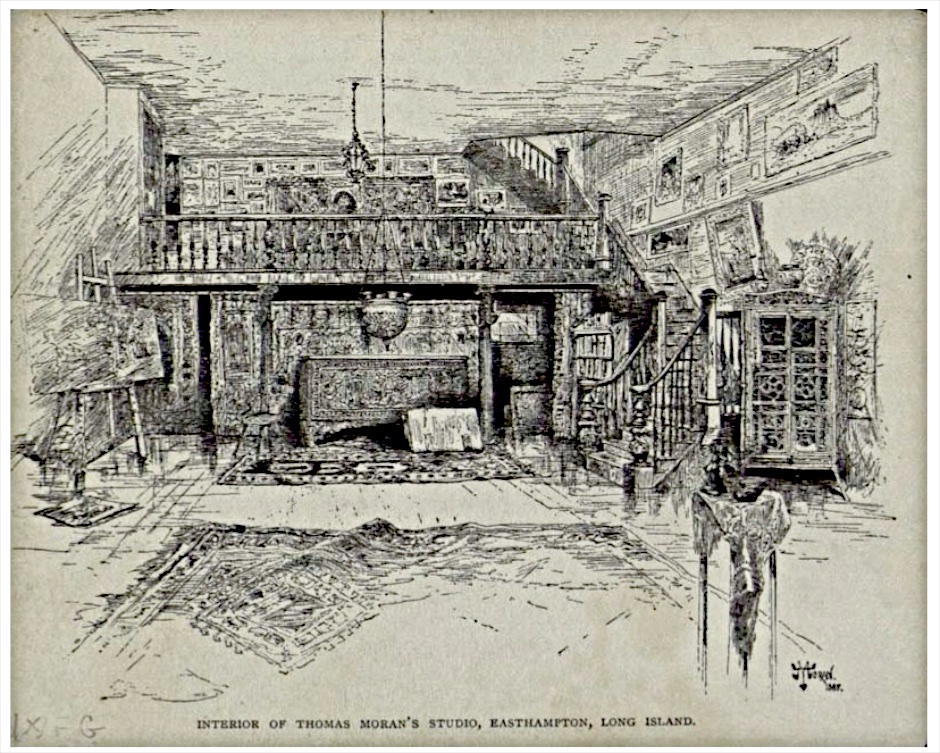 This 1885 etching by Thomas Moran was published in “The Summer Haunts of American Artists,” The Century, October 1885.
This 1885 etching by Thomas Moran was published in “The Summer Haunts of American Artists,” The Century, October 1885.
THE STUDIO AS A WORKSHOP FOR ART
Some of Thomas Moran’s most important work, especially the early watercolors and paintings of the western expeditions, were done before he came to East Hampton. But according to Ruth Moran it was in The Studio that “a greater part of his work was done.” (Ruth Moran). The East Hampton Star noted in Thomas Moran’s obituary: “It was at his East Hampton studio that Mr. Moran painted most of his best works, canvasses that have become famous…” — East Hampton Star, August 27, 1926.
Thomas Moran made sketches and watercolors in the field and from these worked on oil paintings and etched plates in the studio. The interior photographs of the Moran era show one or more easels set up at various locations in the large studio space. An easel and chair would be set by the front doors, in the middle of the room with the canvas facing the north windows, and in front of the east bay window with the canvas facing into the room. A number of photographs show paint, brushes and other supplies on the shelf of the bay window. Supplies must also have been stored in the built-in box of the bay window and in the cabinet beneath the bay window shelf.
———————-
The studio runs the whole width of the house, and the vine-clad porch opens directly into it. You stand in delightful wonderment at first as you look about you, and catch the general birds’ eye or butterfly’s view of the room in which are gathered together in artistic confusion and charm relics from rambles and vacations in every part of this variform world of ours. Across that dark, wood-carved gallery above are thrown the gorgeous vestments, now dulled, now diamonded in the shadows and the sunshine of the studio, of prelates of Brittany, ecclesiastical fragments from Hungary, fragrant moth-eaten robes from old Rome, dimmed but most divine with the sacred smell of incense. Suspended from the ‘gallery,’ swing bulbous bronze delights of mosque and seraglio lamps, some of them glowing with Orient crystals, deep-hued lustrous as the eyes of a Sultan’s favorite or the jeweled splendors of her little sandaled feet. Here are rugs from Persia and Afghanistan; but, more wonderful than all, a chef d’oeuvre, indeed, of the Oriental weaver’s art, who built poems into the warp and woof of this threading thought – here is an Egyptian rug with the coat-of-arms, one might say, of the Pharaohs – the winged disk of the sun from whose blood beat the Egyptian ruler claimed descent, the symbol that he set in dynastic dignity of carven splendor over the temple-entrance of his god. Scarabaeid are woven into the rug’s Egyptian texture; and the flower of the Pharaohs, the lotus that dictated the Greece motif for the columned entrance to her temple of Diana at Ephesus, is the administrator of the gorgeous tones. Mr. Moran prizes it as one of his choice things. — New York Post, October 30, 1897
———————-
FAMILY LIFE IN THE STUDIO
In 1885, when the family moved into The Studio, Thomas Moran was 48 years old, Mary Nimmo Moran was 43, Paul was 21, Mary was 18 and Ruth was 15. The third floor had four bedrooms. Each of the children may have had their own room. Undoubtedly the parents occupied the large room (room 304) with the fireplace, oriel window and large closet.
When Thomas Moran was not painting at his easel the family spent much of their leisure time in the large studio. An upright piano was against the west wall. The large studio space, with few furnishings, provided room for dances and lectures.
The balcony and turret may have provided the family with a place for indoor pursuits when Thomas was working in the studio. As noted in the 1890 description in The East Hampton Star: “across the other end extends a gallery where are placed easy chairs and sofas.” The 1948 inventory lists side chairs, a rocking chair, a Sheraton mahogany folding card table, a studio couch and the 29 volumes of the 1911 Encyclopedia Britannica on the balcony.
The area beneath the balcony was the dining room and was divided from the studio by hanging carpets and drapes. Photographs of the Moran era and the 1948 inventory provide information on the mahogany hepplewhite sideboard that was against the east wall and the oak oval dining table.


ALTERATIONS TO THE STUDIO MADE BY THOMAS MORAN
Through the years Thomas Moran made changes to The Studio. At an early date he added the oriel window to the west bedroom (room 305) replacing the 1884 small dormer window. In 1890 Thomas Moran built a new front porch and used the 1884 porch pediment in a new outbuilding that may have been his Main Beach bathhouse.
In the 1890s Thomas Moran added a second large window to the north wall of the studio. The second window was about equal in width to the 1884 window, but was not as tall. Both windows have identical leaded-glass fanlights and it may be that Moran found these and decided to use them in The Studio, prompting the second window. As noted in the discussion of the studio windows, the 1884 window may have had a different fanlight originally. Newspaper descriptions of the studio in 1890 and 1897 mention only one north studio window. It may be that this second window was installed after 1897.
In 1884 three windows of The Studio had large sash (36” x 78”) that Thomas Moran had salvaged from a commercial building in New York. These were in the bay window of the studio, in the oriel window of the large bedroom (room 304) and in the balcony window. It appears that these sash did not open. Between about 1903 and 1910 Thomas Moran replaced two of these large sash, apparently in an effort to improve ventilation. He installed two casement sash in place of the large fixed sash in the oriel and replaced the large balcony window sash with two sliding sash. A historic photograph (below) indicates that these sash were replaced after the c. 1903 maid’s bath addition was built. The new opening sash are seen in a c. 1910 postcard. The large sash in the studio bay window is the only one of the three to remain in place today.
Thomas Moran made few changes to the studio interior. In the 1890s he installed the grass cloth wainscot and new picture molding in the dining room. About 1900 he installed the fielded paneling beneath the studio bay window and cut a blind door in the west studio wall to the new bathroom. The new strip yellow pine floor over the 1884 studio floor and the fiberboard panels covering the studio’s plaster ceiling appear together in two photographs of the Moran era. These photographs show electric light fixtures and date from after 1903. Other than identifying the painting on the easel, the key to dating these photographs is the square Jacobean style table in the studio which replaced the desk seen in all earlier photographs. This table had been in Thomas Moran’s New York studio. He probably moved it to East Hampton when he closed the New York studio. This may have been around 1912 when he began spending the winters first at the Grand Canyon and then in California. The attributed date of the new floor and ceiling treatment is c. 1912.
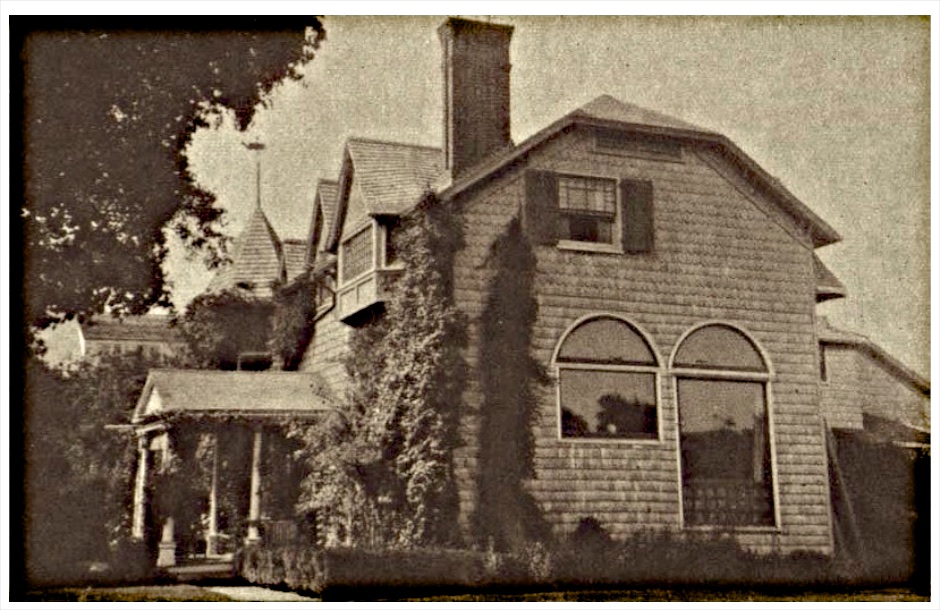 This photograph provides information on the sequence of changes made by Thomas Moran: the second studio window has been installed; the service wing is complete with the c. 1899 and c. 1903 additions; and the 1884 sixty-light sash in the oriel window has not yet been replaced with the two casement sash.
This photograph provides information on the sequence of changes made by Thomas Moran: the second studio window has been installed; the service wing is complete with the c. 1899 and c. 1903 additions; and the 1884 sixty-light sash in the oriel window has not yet been replaced with the two casement sash.
———————
THE LANDSCAPED GROUNDS
The setting of The Studio was very important to Thomas and Mary Moran. The landscaped grounds, like The Studio and its interior decoration, were an integral part of the artistic environment they created. The Moran family lived outdoors for much of the time during the summer. Numerous photographs show Thomas Moran outside with his brush and easel. Mary Nimmo Moran painted in her garden and in Dr. Osborn’s garden and orchard.

Ruth Moran wrote on the back of this photograph: “Garden path to Studio from Main Street. The land is higher than the sidewalk by two steps.” The walkway from Main Street has a border of flowers to the north and a border of shrubs and flowers to the south. A second gravel walkway is to the south with another planted border between it and the fence with the Osborn property.
A fence and honeysuckle hedge were on Main Street. From the hedge a broad lawn ran up to The Studio and into the north side yard. Trees and shrubs on the lawn apparently included apple trees left over from Dr. Edward Osborn’s orchard as well as shade trees and shrubs planted by the Morans. To retain as continuous a lawn as possible, the driveway was placed at the north property line and the walkway from Main Street, rather than aligning with the front door, was set further to the south. The walkway from Main Street intersected a north-south gravel walkway that ran from the 1890 front porch south to a fence to Dr. Osborn’s garden and north to wrap around the north wall of The Studio to the back yard. A picket fence along the south property line separated the Moran property from the Osborn property. The area between this fence and the walkway from Main Street, about ten feet north of the fence, became the site for Mary Nimmo Moran’s garden. Dr. Edward Osborn had an extensive flower border along his side of this fence and Mrs. Moran planted a border on the north side of the fence as well as borders on either side of the walkway. Other flowers and shrubs were planted around the front porch and front wall of The Studio. Vines grew up the walls of the house and into the apple trees.
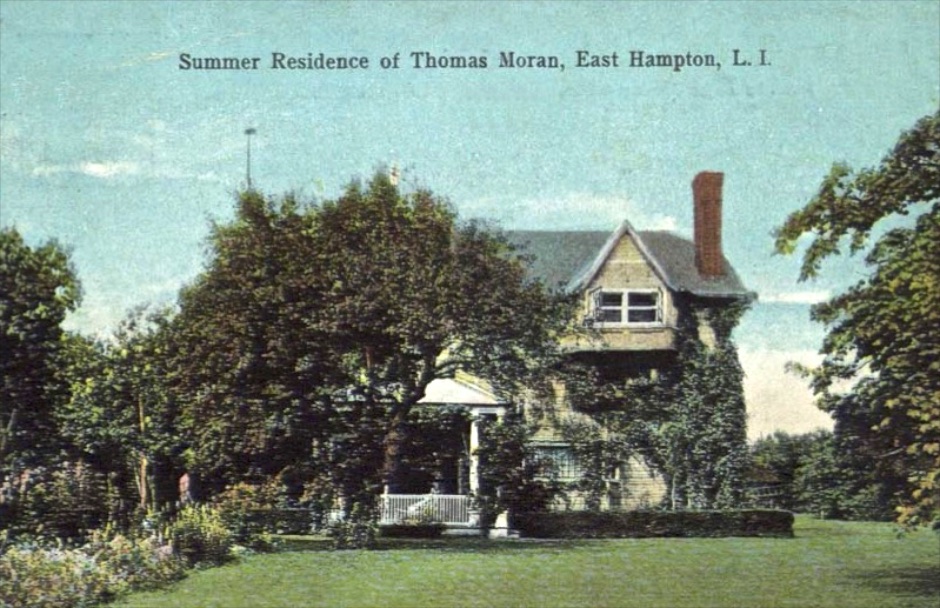 Postcard, c. 1910, showing the flower borders along the walkway from Main Street, the apple tree at the porch and the broad open lawn. Casement sash have replaced the large fixed sash in the oriel.
Postcard, c. 1910, showing the flower borders along the walkway from Main Street, the apple tree at the porch and the broad open lawn. Casement sash have replaced the large fixed sash in the oriel.
~~~~~~~~~~~~~~~~~~~~~~~~~~~~~~~~~~~~~~~
RECOMMENDATIONS
PRESERVATION PHILOSOPHY
[Editor’s Note: Restoration is in Progress. Work began in 2013.]
The Studio has many layers of significance which all should be taken into account when evaluating any proposed treatment or use of the property.
————————
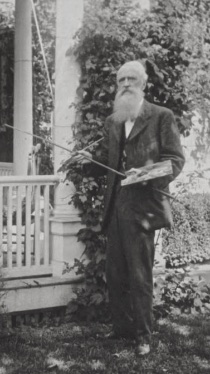
The Studio’s associations with Thomas Moran
The Studio was declared a National Historic Landmark in 1965 for its associations with Thomas Moran. The nomination cites the national significance of Thomas Moran as “the first painter to bring Americans to a consciousness of the natural splendors of the West” and specifically lists the two large paintings purchased by the Federal Government, “The Grand Canyon of the Yellowstone” and “The Chasm of the Colorado.”
Although the above two paintings were completed before Thomas Moran visited East Hampton, he continued to paint important western scenes as well as paintings of Europe, marine paintings and East Hampton landscapes in The Studio throughout his years of residence. Ruth Moran wrote that in The Studio “a greater part of his work was done.”
Thomas Moran’s importance to East Hampton was best expressed by the editor of The East Hampton Star on the occasion of the 1928 memorial exhibition at Clinton Academy:
Mr. Moran was a “discoverer” of East Hampton in one sense for his work presented the beauties of the village to the outside world as probably no artist had done before him; he may be more popularly known for his Grand Canyon and other western paintings but a great bulk of his work portrayed quiet pastoral scenes of this neighborhood; and none could know his work without knowing something of East Hampton.
The Studio is primarily significant for its associations with Thomas Moran who called this his home and lived here during thirty-seven summer seasons from 1885 to 1922.
Portrait of Thomas Moran standing by the 1890 front porch of The Studio.
————————
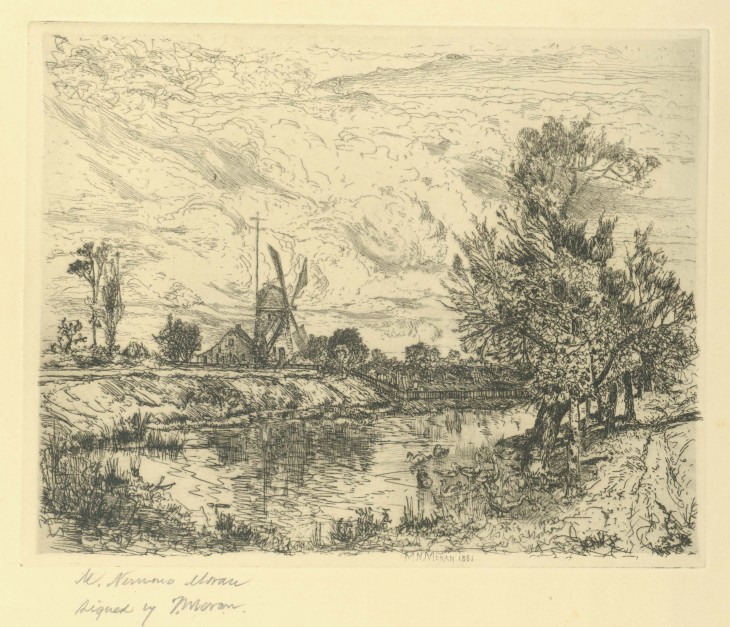
The Goose Pond, etching by Mary Nimmo Moran, 1881, signed by Thomas Moran. Courtesy of the Long Island Collection at the East Hampton Public Library.
The Studio’s associations with Mary Nimmo Moran
Mary Nimmo Moran was a prominent American etcher who was accepted into the New York Etching Club and the Royal Society of Painter-Etchers in London. When reporting on New York exhibitions, The East Hampton Star gave Thomas Moran’s work and Mary Nimmo Moran’s work equal treatment.
Locally, the associations of The Studio and its setting with Mary Nimmo Moran are particularly vibrant because her art focused on the East Hampton landscape. Much of her work was done outdoors close by The Studio in the garden and orchard of Dr. Edward Osborn, at the Gardiner Windmill, at Home Sweet Home and at Hook Pond. Restoring the grounds and gardens of The Studio and enhancing its relationship to the neighborhood setting is particularly important in recalling the life and art of Mary Nimmo Moran.
————————
The Studio’s grounds and gardens
For Thomas Moran and Mary Nimmo Moran the garden setting, the character of The Studio exterior and the interior decoration of the studio were all parts of a whole artistic environment. By siting the driveway and the walkway at the edges of the property, the Morans preserved a broad lawn with apple trees and shade trees. Mary Nimmo Moran’s flower borders were along the south fence and along the walkway from Main Street. There is ample documentation of the grounds and gardens during the Moran era.
————————
The Studio in the setting of the “south end” of Main Street
The neighborhood around The Studio remains remarkably intact from Thomas Moran’s time in East Hampton. Thomas and Mary Nimmo Moran had a close relationship with Dr. Edward and Phebe Osborn, whose house remains next door to the south. The summer cottages of their friends, Dr. Everett Herrick and Dr. George E. Munroe are across Woods Lane. The Hedges Inn and the Osborne House (Maidstone Arms) where the Morans boarded at different times remain as historic inns. The home of Thomas Moran’s close friend Gustav Buek, Home Sweet Home, is now a village museum with an interior restored to the Buek era featuring his collection of antiques and art. The subjects of sketches, paintings and etchings by Thomas Moran and Mary Nimmo Moran are nearby, including Town Pond, the Gardiner Windmill, Home Sweet Home and Hook Pond. The Moran monument is in the South End Burying Ground set as mentioned in Mary Nimmo Moran’s obituary “opposite the old wind-mill that has so often been a feature in her paintings and etchings.”
Thomas Moran actively maintained the pastoral character of his neighborhood by building a windmill that pumped water into Town Pond during the summer and by preventing trees around Town Pond from being cut down.
The Studio is a National Historic Landmark because of Thomas Moran’s paintings of the American west, but in planning for this property in its local context it is Thomas and Mary Nimmo Moran’s connection with the East Hampton landscape that is important.
————————
The Studio as a summer cottage
The Studio is among the most intact examples of a nineteenth-century summer cottage in East Hampton. The Studio is the first summer cottage to become a historic site that will be open to the public. For years to come The Studio may be the only opportunity for the public to experience the kind of cottage that marked the beginning of East Hampton’s history as a summer resort. Thomas and Mary Moran were very much a part of the summer colony and their home is also significant as an example of an early summer cottage.
————————
Restoration period
For this property to most clearly recall the life of Thomas Moran, The Studio should be restored to its appearance when Thomas Moran lived here, retaining all the significant changes that he made. A restoration that represents the full period of Thomas Moran’s residence will have the greatest authenticity and will not diminish the ability of the property to also evoke the life of Mary Nimmo Moran.
Thomas Moran continually made changes to The Studio. In 1887 he constructed a new kitchen wing. Before 1890 he added an oriel window to the west wall. In 1890 he built a new front porch. In the 1890s he added a second studio window in the north wall with a leaded-glass fanlight and at the same time may have installed the same fanlight over the 1884 studio window. The dining room was redecorated in the 1890s with the grass cloth wainscot and about 1900 Thomas Moran put the fielded paneling under the studio bay window. The service wing was expanded around 1899 with the three-story addition which provided bathrooms for the third floor and again around 1903 with a maid’s bathroom. Between about 1903 and 1910 Thomas Moran replaced the large sixty-light fixed sash of the balcony window and of the front oriel window with pairs of smaller sash that would open.
All these changes made by Thomas Moran should be retained. In giving more definition to a restoration period, a date of 1916 may make sense. In 1917 Santa Barbara became his new home and his visits to East Hampton became shorter. It does not appear that any changes were made to the property between 1916 and Thomas Moran’s last visit in 1922 except for the removal of some of the contents of The Studio to Santa Barbara.
The associations of this property with the life and art of Mary Nimmo Moran are strongest in the grounds, in her garden and in the artistic environment of the studio, dining room, balcony and turret which she and Thomas Moran created in 1885. The grounds and garden and the interior decoration remained essentially the same throughout the period 1885 to 1916 so that a restoration period of 1916 recalls both the full lives of Thomas Moran and of Mary Nimmo Moran in The Studio.
This recommendation includes restoring the service wing to its appearance in 1916. A restored service wing would complete the picture of how Thomas Moran and his family lived in The Studio. The service wing is also significant as being a typical feature of an early East Hampton summer cottage.
Such a restoration would include retaining all existing features of The Studio that date from the Thomas Moran era, restoring missing features of The Studio as it existed in 1916 and removing additions and alterations made after 1916. The floor plans (drawings 1 – 3) identify the Thomas Moran-era spaces and features that would be retained and restored and the non-historic additions and features that would be removed.
———————————-
THE STUDIO
THE HOME AND WORKSHOP OF THOMAS MORAN AND MARY NIMMO MORAN
229 MAIN STEET, EAST HAMPTON
HISTORIC STRUCTURE REPORT
Prepared by: Robert Hefner
With research by: Rosanne Barons
April 2009
Prepared for:
The Inc. Village of East Hampton
AAQ Portfolio: select photographs, illustrations, drawings, with copy excerpts from original report. To see copy of complete report, please contact the Village of East Hampton.
————————————-
Visit Thomas Moran Portfolios in AAQ’s Art and Preservation Sections.
Also, visit: www.thomasmorantrust.org

